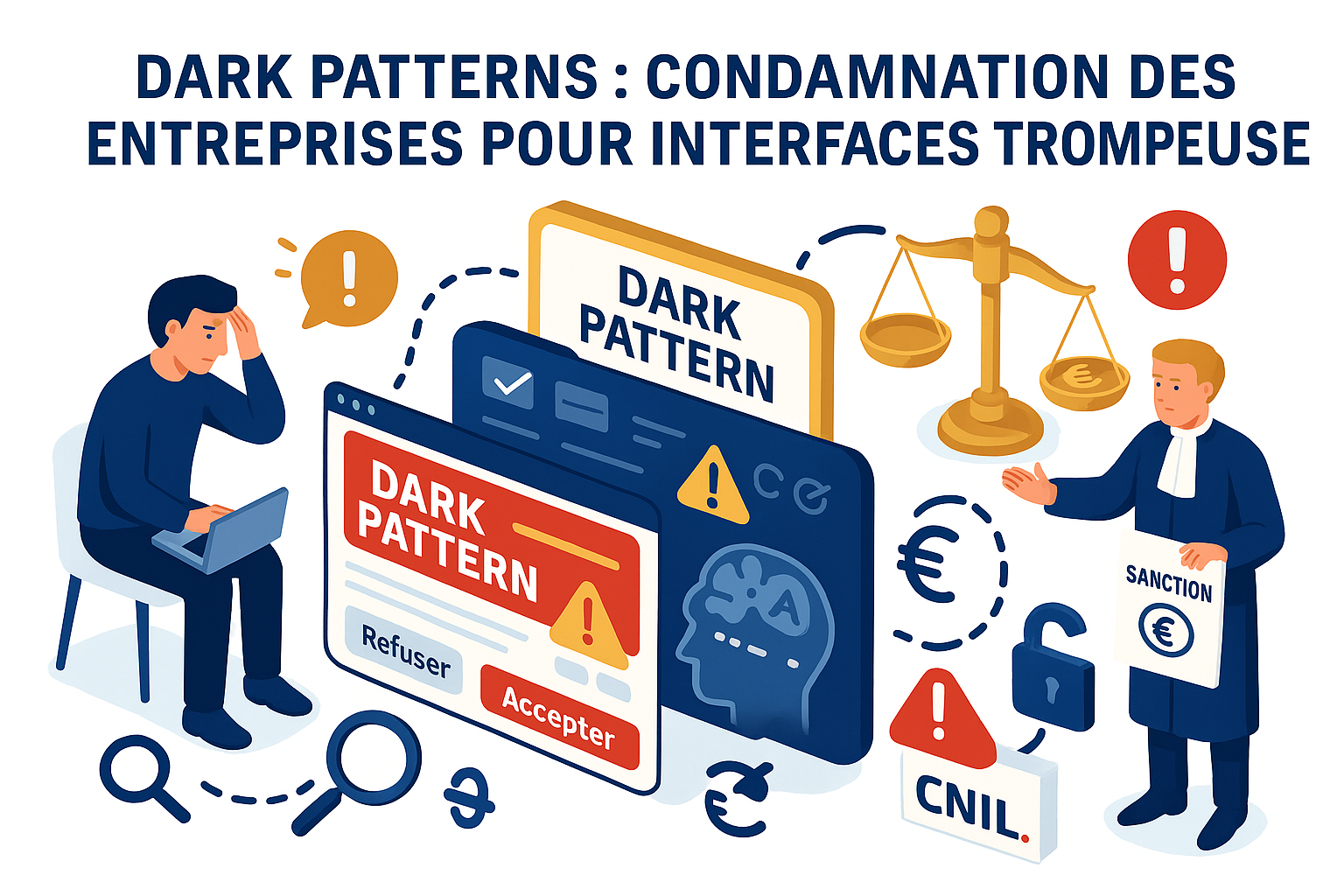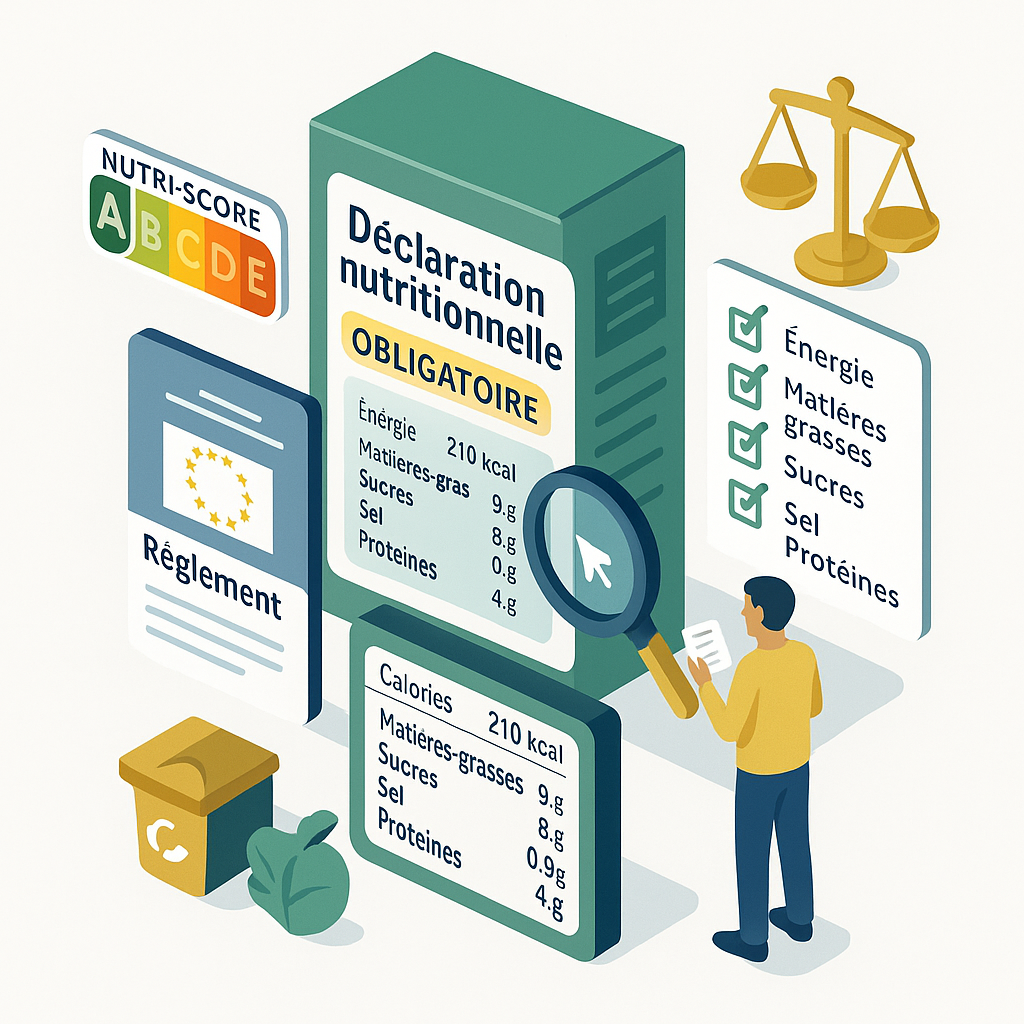In the digital world, an insidious practice has gradually spread before attracting the attention of regulators: dark patterns. These user interface techniques are specifically designed to manipulate consumers' online choices, subtly pushing them towards decisions they wouldn't have made spontaneously.
Far from being anecdotal, these practices now have a considerable impact on millions of users every day. Faced with this reality, European and international authorities have decided to strike hard, inflicting spectacular sanctions on several web giants.
If you need a digital lawyer, contact me!
Record sentences change the game
The most resounding case is undoubtedly that of Meta, parent company of Facebook and Instagram, which was fined a colossal 390 million euros by the Irish regulator in January 2023. At the heart of the case: a cookie consent system designed to discourage users from refusing ad tracking. The interface featured an easily accessible "Accept All" button, while the opt-out option required several clicks in secondary menus. This deliberate asymmetry was deemed contrary to the principle of free and informed consent imposed by the RGPD.
Amazon was not spared either, with a 746 million euro penalty imposed by Luxembourg's Commission Nationale de Protection des Données. The e-commerce giant had designed its Prime unsubscription process in a deliberately complicated way, multiplying psychological obstacles and dissuasive screens. This strategy, dubbed "roach motel" (it's easy to get in, but impossible to get out), is now explicitly prohibited by European legislation.
Even more recently, Booking.com was fined 400 million euros by the Italian competition authority for several dark patterns, including the use of false emergency messages ("Only 2 rooms available!") and incomplete prices revealed late in the booking process. This decision marks a turning point, as it now clearly associates these practices with breaches of consumer law.
Techniques now prohibited by European legislation
The European Union has taken the lead in the fight against these deceptive practices with the adoption of the Digital Services Act (DSA) and the Omnibus Directive. These texts identify and formally prohibit several categories of dark patterns that companies must now ban from their interfaces, on pain of heavy penalties.
Among the practices now prohibited are bait-and-switch (luring the user with an offer, only to modify it later), fake countdown timers (creating a false sense of urgency), and sneak into basket (automatically adding unsolicited products to the basket). Making the user feel guilty by using messages such as "Don't you care about your safety?" to force acceptance is also strictly prohibited.
The concealment of essential information in interfaces is particularly targeted. Travel sites that only display additional charges at the last moment of booking, or online stores that hide return conditions in hard-to-locate sections, now face significant penalties.
The use of a lawyer in auditing user interfaces is becoming essential for companies wishing to avoid these regulatory pitfalls. These professionals can identify the problematic elements of an interface, assess their compliance with the new European directives and propose appropriate corrections. Their expertise not only helps avoid considerable financial penalties, but also preserves a brand's reputation - a crucial factor in an environment where consumers are increasingly sensitive to issues of digital ethics.
Consumer associations on the front line
Mobilization against dark patterns has grown considerably thanks to the determined action of organizations such as the European Consumers' Organisation (BEUC) and its national equivalents. In France, theUFC-Que Choisir and the CNIL have developed cutting-edge expertise in identifying and reporting these deceptive practices.
These organizations have set up sophisticated monitoring systems to spot dark patterns on high-traffic sites. Teams of experts methodically analyze the user paths of major online services, precisely documenting problematic interfaces. This documentation is then used as evidence in administrative or legal proceedings.
The strength of these associations lies in their ability to launch collective actions. By grouping together the complaints of thousands of consumers, they exert considerable pressure on the targeted companies. In 2024, a landmark class action brought together over 70,000 complainants against a travel booking platform, resulting in an exemplary conviction and a complete overhaul of its interface.
Concrete risks for French companies
French SMEs and ETIs should not consider that this issue only concerns the web giants. The national authorities have clearly indicated their intention to apply these new rules to all companies, whatever their size. Several recent sanctions against medium-sized players demonstrate this intention.
In 2024, the DGCCRF (Direction Générale de la Concurrence, de la Consommation et de la Répression des Fraudes) fined a French e-commerce SME 150,000 euros for using dark patterns in its shopping tunnel. This amount, representing almost 4% of its annual sales, had a significant impact on its cash flow.
Beyond the financial penalties, the consequences can be disastrous in terms ofbrand image. Convictions for deceptive practices receive extensive media coverage and are widely relayed on social networks. Recent studies show that a majority of consumers now say they are turning away from brands identified as using dark patterns.
The risk of litigation also extends to B2B relationships. Corporate customers can hold their digital service providers liable if the interfaces designed for them contain dark patterns that have led to sanctions. A new body of case law is developing around these disputes between professionals, where the financial stakes can reach several million euros.
Towards a digital ethics of interfaces
Faced with these major regulatory changes, a new approach is emerging: ethical design. This movement advocates interfaces that respect users' choices, are transparent in their operation and fair in the options they offer. Far from being simply a constraint, this approach also seems to be bearing fruit in commercial terms.
Recent studies show that companies that have adopted ethical design practices enjoy greater trust from their users. This trust translates into greater loyalty and a higher recommendation rate. Respect for user autonomy thus appears to be a long-term competitive advantage.
Some organizations have even developed ethical design certifications, enabling companies to have their interfaces validated by independent bodies. These labels, still in their infancy, could become industry standards in the years to come, offering a differentiating advantage in competitive markets.
User experience (UX) professionals are now systematically integrating these ethical considerations into their working methodologies. Ethical audits are conducted in parallel with traditional usability tests, to identify and eliminate any manipulative elements in interfaces under development.
Towards an overhaul of digital practices
The recent sanctions against dark patterns mark a decisive turning point in the regulation of the digital world. The era when companies could freely design manipulative interfaces seems to be definitively over in Europe. This development is part of a broader movement to make digital players more accountable, which also affects personal data protection, content moderation and algorithmic transparency.
For companies, the best strategy is now to integrate these ethical requirements right from the design stage of their digital products and services. This " compliance by design " approach not only avoids sanctions, but also builds a lasting relationship of trust with users. In a context of growing mistrust of digital players, this trust becomes an invaluable strategic asset.
While the transition to respectful interfaces represents an initial investment, the long-term benefits - protection against sanctions, enhanced brand image, customer loyalty - seem to more than offset these costs. Companies pioneering this ethical approach could well have a significant competitive advantage in the years to come.
The fight against dark patterns is probably only the beginning of a profound transformation of our digital environment. Regulators and consumers alike are demanding respectful, transparent and fair online experiences. Companies that anticipate these expectations will be best positioned to thrive in this new digital paradigm.




